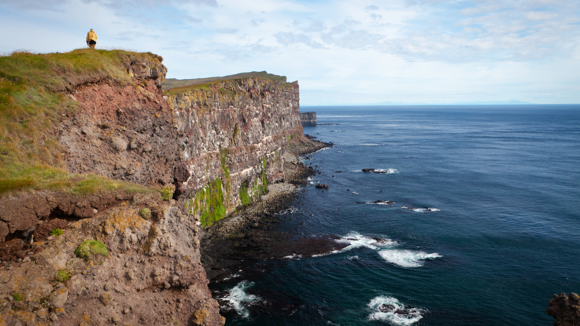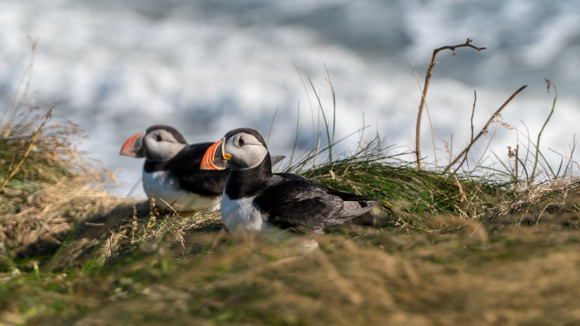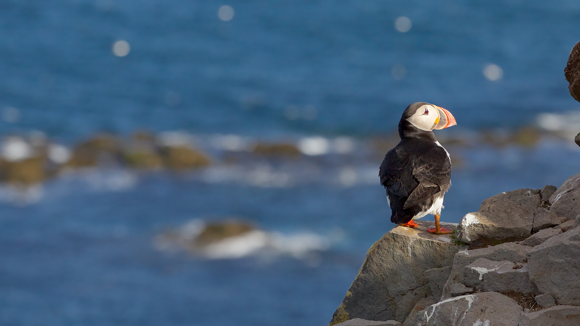See Puffins at Látrabjarg in the Westfjords

Puffins might just be Iceland’s most charming creatures. With brightly coloured beaks and a flying style that would catch your eye, hundreds of tourists flock to Iceland during puffin season to try to catch a glimpse. But finding puffins in Iceland is as much planning as it is chance. Maximise puffin potential at one of the best seabird-spotting locations in the country - Látrabjarg.
Látrabjarg Cliffs - A Seabird Haven
Látrabjarg is the longest stretch of sea cliff in Iceland, reaching a whopping 8.75 miles (14 kilometres) along the northwest point of the island. It is the westernmost point of Iceland and the rest of Europe. The wild and untamed coastline really shows the effect of strong winter storms in the area. What is left behind are steep cliffs with signs warning visitors to stay a safe distance from the edge.
Its highest peak stretches some 1,447 feet (441 metres) into the air, making it the ideal location for flocks of seabirds of all kinds to nest. Whether you’re in the Westfjords for the stunning hiking opportunities, the abundance of wildlife or on your very own road trip, the Látrabjarg puffins make for a charming stop.

Puffin Watching at Látrabjarg
If you’re dead set on puffins while you’re here in Iceland, the Látrabjarg bird cliffs are an absolute must. If you find the right spot, you’re almost guaranteed to see flocks of these curious little creatures along the cliffside. The best time to see Atlantic Puffins at Látrabjarg is between May and September. This is because around 10 million birds flock to the island to nest and mate from over the ocean.
Other areas in Iceland also attract puffins and other sea birds, including the Westman Islands to the south and the appropriately named Puffin Island in Husavik.
Dos and Don'ts for Visitors to Látrabjarg
While we understand that you want to get as close as you can to the birds, either for pictures or the best angles, it’s critical that visitors to Látrabjarg are careful and considerate of their environment. Responsible travel is encouraged all across Iceland, and more so than ever in seabird territory. Here are a few points to remember while on the bird cliffs in the Westfjords, or anywhere in Iceland that’s rich with wildlife.
1. Never try to touch the birds.
This should be an absolute no-brainer. Puffins have an oily coating that helps to keep them waterproof when out at sea. Human touch can rub this away, leaving them vulnerable when they most need protection.
2. Don’t get too close.
Remember that this is their land, not yours, that you’re encroaching on. Don’t stick your camera lenses in their faces, keep a safe distance to prevent disturbing nests or scaring the birds.
3. Be careful of the cliff edge.
Puffins burrow beneath the ground, so while the ground may look sturdy, be vigilant in staying back from the cliff’s edge. There should be a white line drawn in the terrain which you should refrain from crossing.

How to Get to Látrabjarg Cliffs
This area of sea cliffs is the most western point of the entire country and, in fact, the whole European continent, located in the Westfjords. The Westfjords are a considerable distance from Reykjavik, a 6-hour drive if no stops are taken. You’ll follow the Ring Road from the capital before joining Road 60 towards the Westfjords further north. There are plenty of magnificent stops to make on the way, so it can be worth embarking on this journey as a part of a longer road trip like Bolafjall Mountain and Dynjandi Waterfall. Alternatively, it’s also possible to drive instead to Stykkisholmur before catching a ferry to the Westfjords.
GPS Coordinates: 65.502572 N, -24.531698 W
If the main focus of your trip is the sea cliffs here, it’s probably best to choose a base nearer the Westfjords if you’re to make the most of Látrabjarg, like the Fosshotel Westfjords near the fishing village of Patreksfjörður.